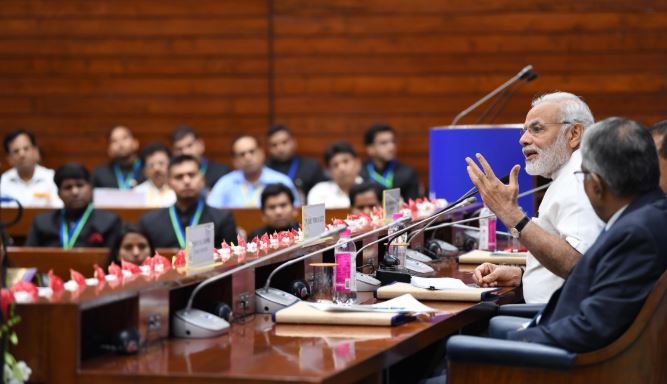Since taking administrative power after the massive electoral victory in 2014, innovation and reforms in Indian bureaucracy has been one of the top agendas for the Narendra Modi government. While the officers of prestigious services like the IAS, IPS, IRS and others have been largely supportive of these changes, some inertia has nonetheless been present. However the Modi Government, more so in its second term with a fresh and even stronger mandate, has evidently been successful in kick starting the wheel of reforms in these central services which for long have been marred under allegations of corruption and inefficiencies.
In a recent meeting with top bureaucrats of the nation, PM Modi has again reiterated his views regarding Indian Bureaucracy and said, “Apne mere paanch saal barbad kiye hai, main apko agle paanch saal barbad nahin karne doonga,” ( You spoiled the first five- years of my tenure but I will not allow you to spoil the second.). He held the bureaucracy responsible for delays in delivering good governance. Since its conception, the Indian bureaucracy has largely focused on the processes and not outcomes. PM Modi’s comments came at the conclusion of an unsatisfactory meeting to review the government’s “Ek Bharat, Sheshtra Bharat” programme on October 12. Interacting with trainee IAS officers with the Statue of Unity in the backdrop PM Modi had also reminded the trainee that the time for effective accountability in bureaucracy is here.
The administration is currently holding the 94th Foundation Course for 744 candidates to be appointed in IAS and other Group A services from August 26 to December 6, 2019, the government has made the right beginning with a six-day module at the feet of the Sardar Patel statue at Kevadia village in Gujarat. The 94th Foundation Course’s trainees were also exposed to the future of technology and exponential thinking, the officer trainees were made aware of several issues and trends and their possible impact on the Civil Services: artificial intelligence, Big Data, the future of manufacturing and logistics, and other such.
One of the major pushes by the Government to revive the bureaucracy has been its lateral entry scheme, under which a number of domain experts from the private field are being fetched to work for the government not only giving a fresh perspective to bureaucratic positions but also opening up opportunities for many eligible and competent citizens to take on the public services route. The Modi government has also decided to hold a common foundation course for all Group A services including the Indian Administrative Service (IAS) from 2020-2021 which is certainly poised to a major step towards breaking the elite clubs that function within the Indian bureaucracy.
Modi government in its second term is also poised to expand the policy of lateral entry that would facilitate recruitment of at least 40% of officers at the joint secretary level from outside the system. The Modi government has been a firm proponent of bringing in domain experts in critical positions which call for niche knowledge and experience. The government’s plan to synergize existing talent pool with fresh minds from outside is sure to help deliver better results on several fronts.
Moving forward the Modi Government had also recently appointed nine non-governmental professionals as joint secretaries in various government departments. UPSC had released the list of professionals who joined various government departments. These departments are agriculture, cooperation and farmers welfare, civil aviation, commerce, economic affairs, environment, forest and climate change, new and renewable energy, road transport and highways, and shipping. However, this time around a fresh batch of around 55 officers will be selected through NITI Aayog, instead of UPSC. According to sources, the government is planning to put out advertisements for about 50 positions in NITI Aayog for different positions including directors, joint secretaries, additional secretaries, etc.
Modi government has also been proactive cracking down on corrupt officials, around a hundred officers have been asked to retire citing irregularities in their conduct ranging from charges of corruption, collecting and giving bribes, smuggling and even criminal conspiracy, under the Rule 56(J) of Central Civil Services (Pension) Rules, 1972 which provides for periodical review of the performance of government servants with a view to ascertain whether they should be retained in service or retired in public interest. Several of the officers retired had also been accused of misusing their powers and harassing honest taxpayers, either by targeting honest assesses or taking excessive action for minor or procedural violations.
PM Narendra Modi’s plan to revive the Indian bureaucracy is sure a positive step ahead to churn the old system which is considered inefficient and corrupt by many. It is to note that the tussle between the political executive and the bureaucracy has largely stayed under the table, nonetheless several developments sure point towards the efforts of the current administration to further improve these prestigious services.
